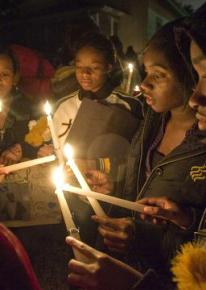We want justice for Kiwane
reports on a vigil and other demonstrations following the death of a 15-year-old at the hands of police in Champaign, Ill.
CHAMPAIGN, Ill.--The killing of an unarmed 15-year-old by police has touched off a surge of anger and protest among the African American and progressive communities here.
On October 14, more than 750 people--among them family and friends, local community members and Champaign-Urbana-area activists--gathered for a vigil and march in memory of Kiwane Carrington, who was shot dead by Champaign police five days before.
Though details are still emerging, it is clear that this killing was a terrible crime.
Friends described Kiwane as a loving and vivacious boy who was still recovering from the death of his mother last year due to pancreatic cancer. He attended READY, a small alternative school run by the Regional Office of Education, where students and faculty are in shock.
According to the school's director, Donna Shonk, "Kiwane was cared about by everybody. All the teachers and staff enjoyed him. They're struggling." Leanetra Moore, a friend of Kiwane's family, said the incident was "wrong. I feel the family's pain. It was a young boy who got killed."'

According to police, a neighbor called 911 to report an attempted burglary on the northwest side of town. Officer Daniel Norbits and city Police Chief R.T. Finney arrived on the scene to find Kiwane and another 15-year old African-American boy trying to get into a house. The police claim that after the two kids resisted the officers, a scuffle broke out, and a firearm "discharged," putting a bullet through Kiwane's heart.
But the police version has been questioned. Deborah Thomas, who lives at the house where police thought a break-in was occurring, said Kiwane was "like a son," and he was "welcome" at the house he was trying to get into.
At a press conference at the Urbana-Champaign Independent Media Center on October 12, Thomas added that the police "tore my house up. I still have no back door." Some people have alleged that police tore the back door off its hinges to make the scene appear like a break-in.
Suspicions were also raised by the police's strange conduct. Kiwane's relatives were first notified about 2 hours after the shooting, and when they rushed to the ER at a local hospital, they were told to go instead to the police station.
Even more importantly, why did a Champaign officer pull a gun on unarmed juveniles? After initial silence about his identity, Champaign police admitted that Norbits, a 14-year veteran of the force, was the shooter. Norbits was also involved in the death of a developmentally disabled person, who was beaten by police in an alley in Champaign in 2000.
Norbits has been placed on paid administrative leave pending a state police investigation into Kiwane's death. The other youth involved faces a juvenile Class 4 felony charge of aggravated resisting a peace officer, which could carry the maximum juvenile prison sentence of three years.
Speakers at the vigil highlighted the fact that this killing wasn't so shocking to a community that is regularly subjected to racial profiling, harassment and abuse by police.
It's clear that Kiwane's killing has touched a nerve. More actions are planned to put pressure on public officials to win justice for his family. Community activists packed a Champaign City Council October 20, and on October 22, demonstrators at a protest coinciding with the October 22 national day of action against police brutality will call for justice for Kiwane Carrington.


